Take a Hike, Stress!

“Giving yourself permission to feel a certain way or do a certain thing. I think giving yourself permission is such an important aspect of self-care and is not an easy thing to practice.”
— User Interview
Abstract
Experience: Mobile & Physical
Type: Concept - Stress Buddy
User Persona: Lily
Objective: A mobile app designed to connect Lily with a therapist who will join her in a physical activity like hiking or going to the gym.
Overview
Summary
A mobile app designed to connect Lily with a therapist who will join her in a physical activity like hiking or going to the gym.
“Health is important” is a hard claim to refute but so often it is associated with just the physical, keeping healthy by eating right and exercising, with no mention of one’s mental health. How we manage our mental health when stressed through self-care is critical and was the prompt for this project.
Hypothesis
Family and friends of patients with serious or critical illness find themselves taking on new roles, dealing with unforeseen problems with the care of loved ones, of themselves and maintaining family accounts, finances and schedules. Those afflicted tend to also change behavior and emotion causing stress and anxiety for those around them. How are family and friends taking care of their own mental health during this in such an ambiguous time?
Project Brief
Duration: 3 Days
Deliverables: Usability Report, Presentation Deck
Team: Solo
Role(s): UX/UI Designer & Researcher
Methods: Context & Problem Space Research, User Research (Screener & Interviews), User Persona & Journey, Storyboard, Wireframes, Rapid Prototyping, Usability Testing & Synthesis
Tools: Google Docs, Marvel, Pen & Paper
Research
My hypothesis was too closely related to my own experience of caring for sick loved ones but it offered up…
Initial problem statement:
Family and friends are often affected by the critical illness of a loved one in unexpected ways.
Those helping loved ones with serious illnesses find themselves in unexpected roles and unsure of how to react to what is happening, stressed and sometimes feeling stretched thin. How might we help them find an outlet to connect with others and information on how to navigate in this ambiguous time to maintain their own mental/physical health?
My research goals:
- How are family and friends affected by critical illness of a loved one?
- How are they taking care of themselves?
- What new roles do they have?
- How are they balancing care for loved one and self?
Target Users
I sourced users around me that had some experience themselves with stress caused by health issues of loved ones.
User Interviews Brief
- 6 Users Interviewed
- Between the ages of 25 - 63 years old
- Occupations ranged from Web Designer, Student, Public School Teacher, Television Production Assistant
Sample Interview Questions
- How would you define self-care?
- How do you practice self-care?
- Can you describe a time when this might have changed or you struggled to maintain this?
- How did you seek or self support during this time?
- How might sharing your experience help others?
“Being aware with her, like when go out to eat or when she comes over the house to eat, help her maintain what is going in her body.”
— User Interview
Synthesis
Empathy Map
Using the Empathy Mapping Technique I gained insights from my users.
Insights
- Users use physical activity as therapy
- Users value figuring out on own but finds comfort in friends listening
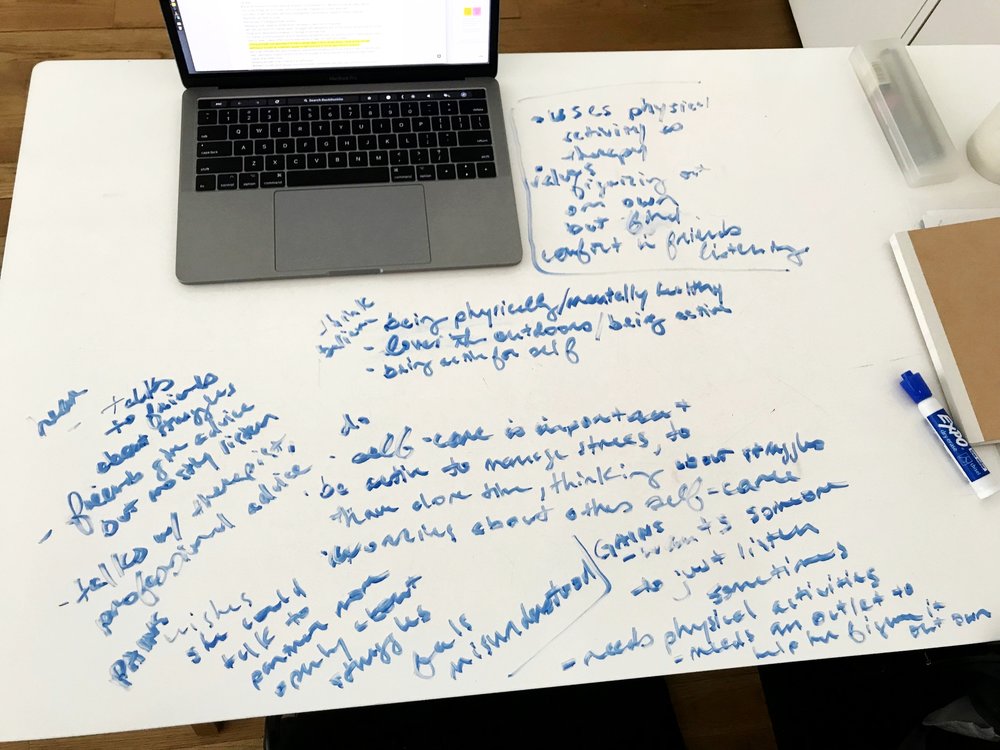
Affinity Map
Using the direction gained from my Empathy Map and pulling insights together in an Affinity Map revealed 6 key trends:
- Difficulties Understanding Others & How To Help
- Talking vs Listening
- How To Self Care
- Being Physical To Manage
- Difficulties Maintaining Self Care
- Views On Professional Help
I decided to focus on Difficulties Understanding Others & How to Help, Being Physical to Manage and Views On Professional Help because users needed access to friends and physical activity.
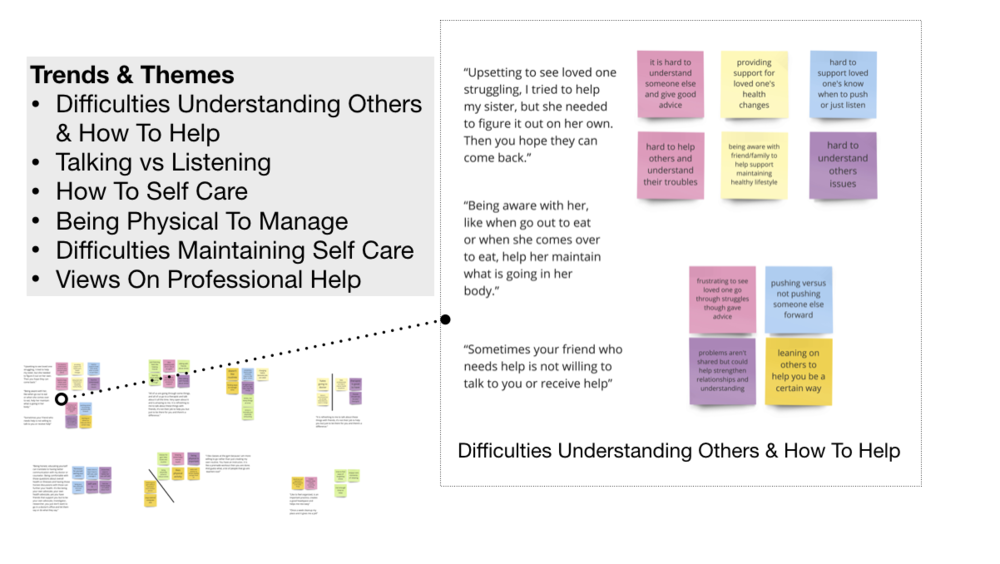
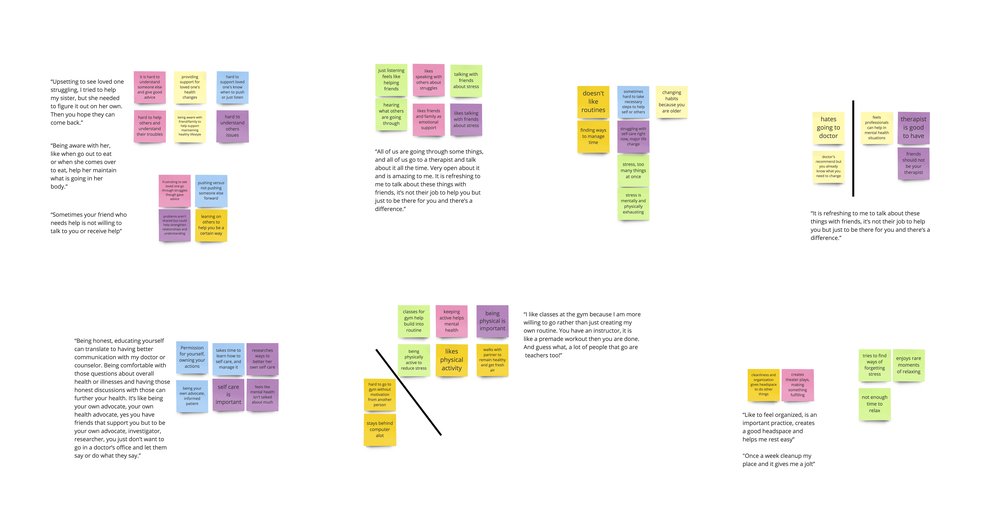
User Persona
Lily was born from the synthesized research.
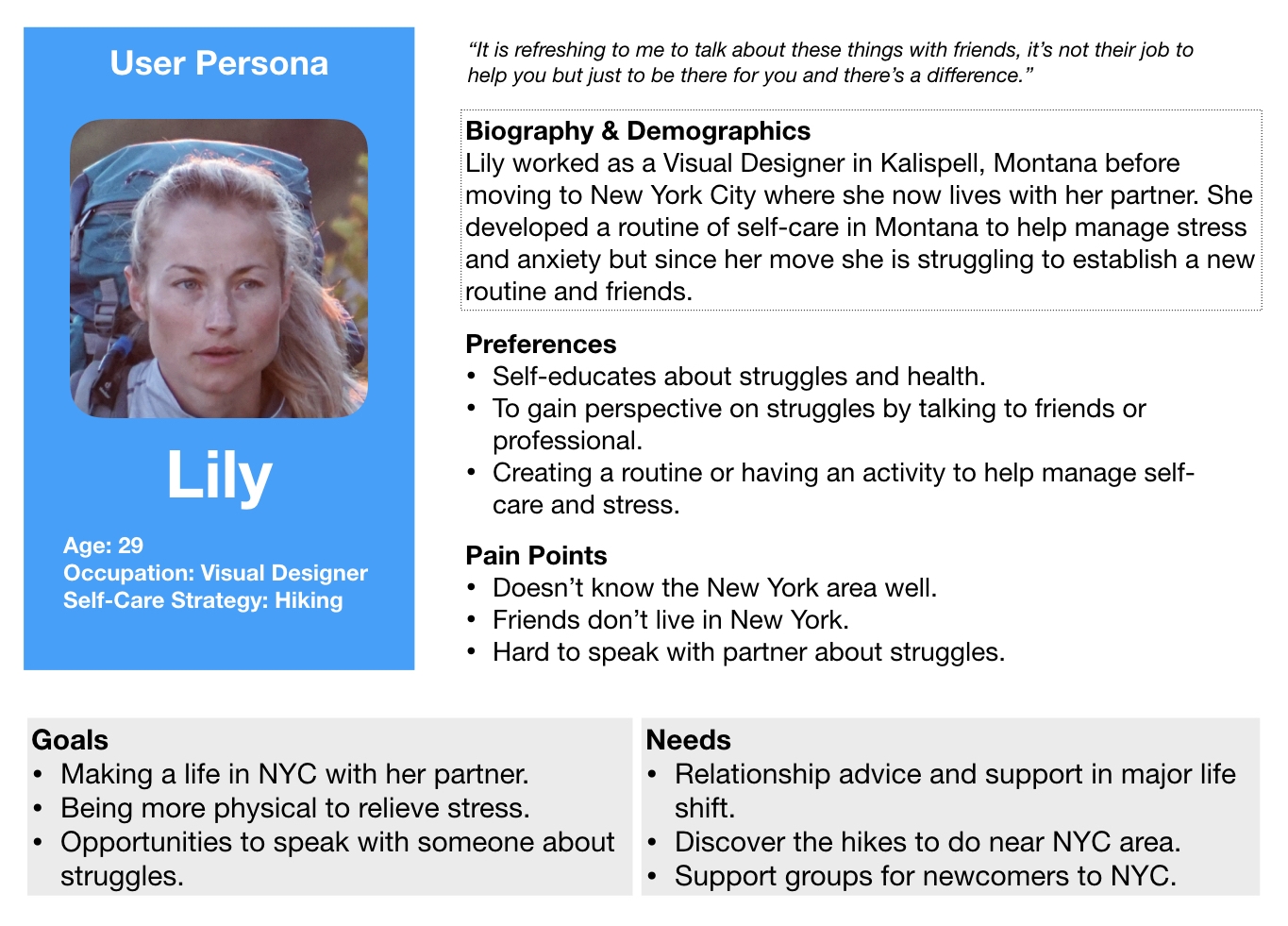
Pivot
Problem Statement Revisited & Revised
I discovered that my initial problem statement didn’t accurately address Lily’s issues, so I revised:
Family and friends lacking resources or motivation often struggle with self-care which also affects those around them.
Lily recently moved to New York City with her partner but struggles to develop a new self-care regiment which is affecting her relationship and happiness. How might we help Lily discover a new self-care regiment allowing her to find ways of relieving stress and to support her in talking about her new struggles
Design
Ideation
Now it was time to brainstorm possible solutions.
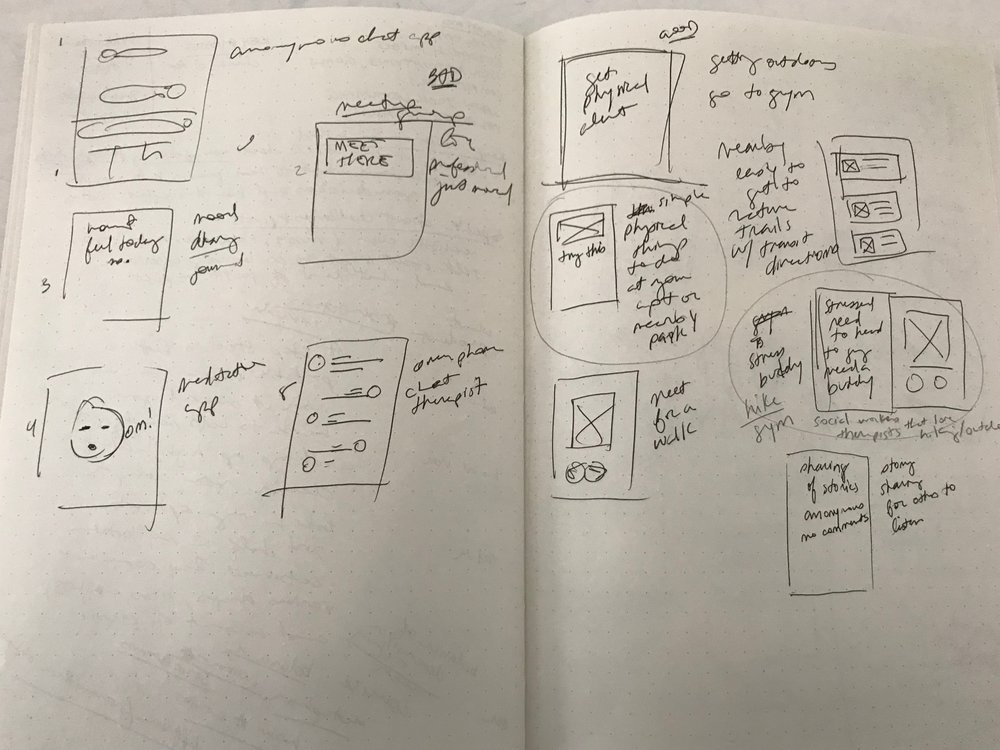 Timeboxed 5 Bad & 5 Good Ideas
Timeboxed 5 Bad & 5 Good Ideas
Storyboard
Storyboarding allowed me to explore the idea of Lily discovering a therapist she wanted to speak with while enjoying the outdoors. I began to imagine the app as a way to connect with a personal outdoor therapist.
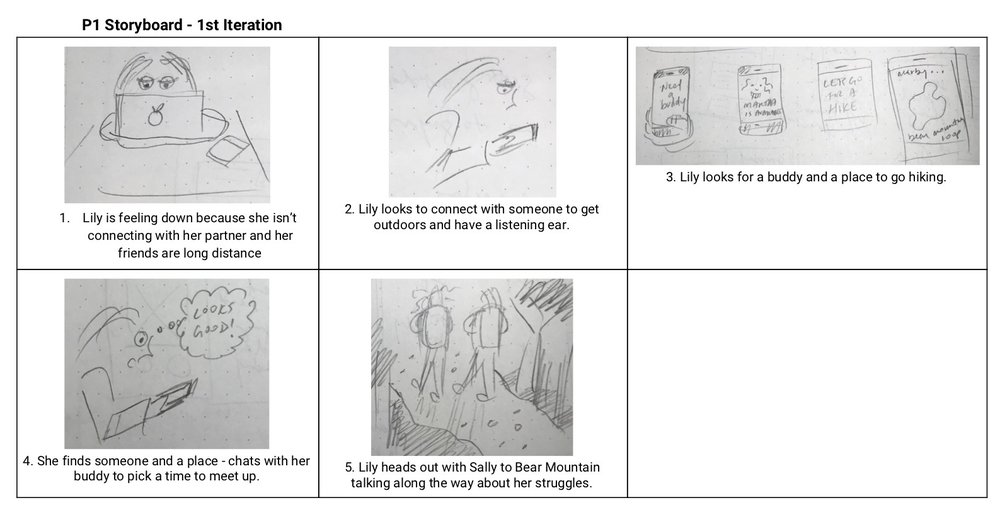 Lily’s Story
Lily’s Story
Wireframes
The user flow would run in three different ways:
- Nature Icon -> Choosing Therapist -> Nature Activity with Therapist -> A Way to Chat with Therapist to Organize Meet Up
- Dumbbell Icon -> Choosing Therapist -> Picking Nearby Gym to Workout with Therapist -> A Way to Chat with Therapist Before Meeting
- Home Icon -> Choosing an Exercise to do at Home -> Video + How To Steps
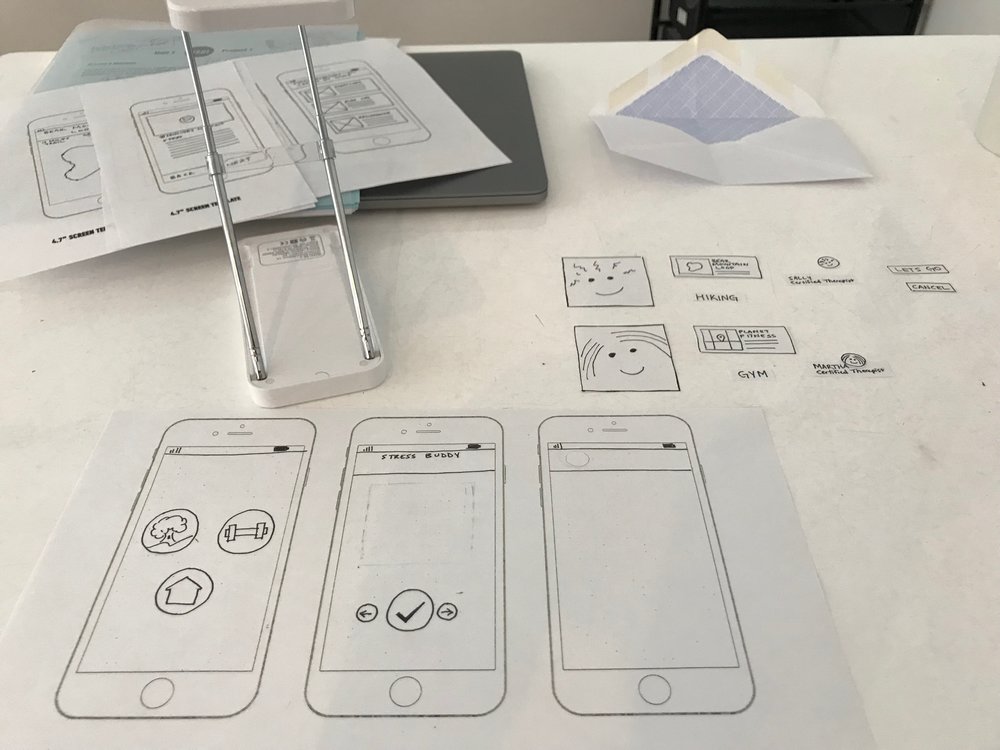
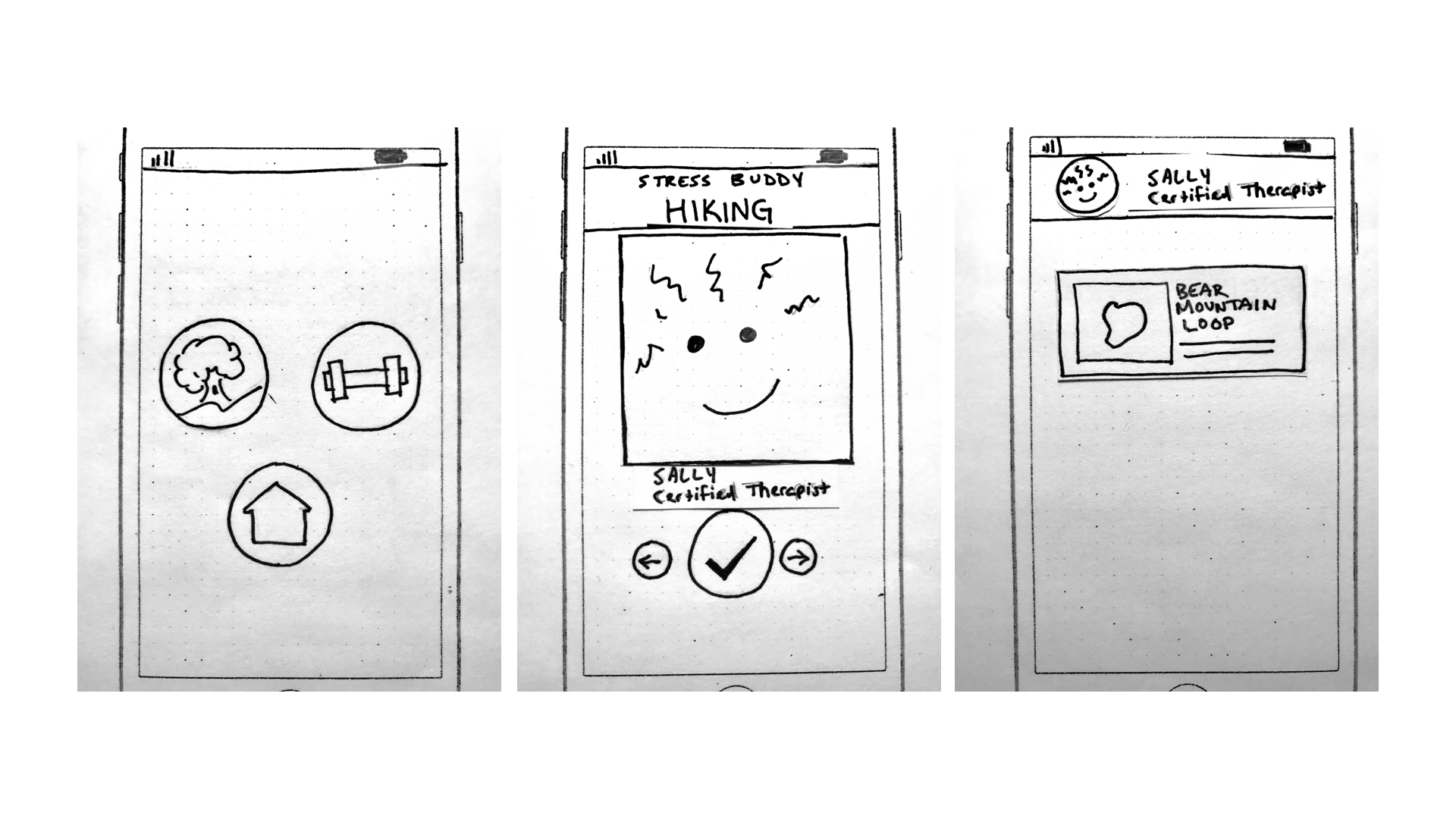
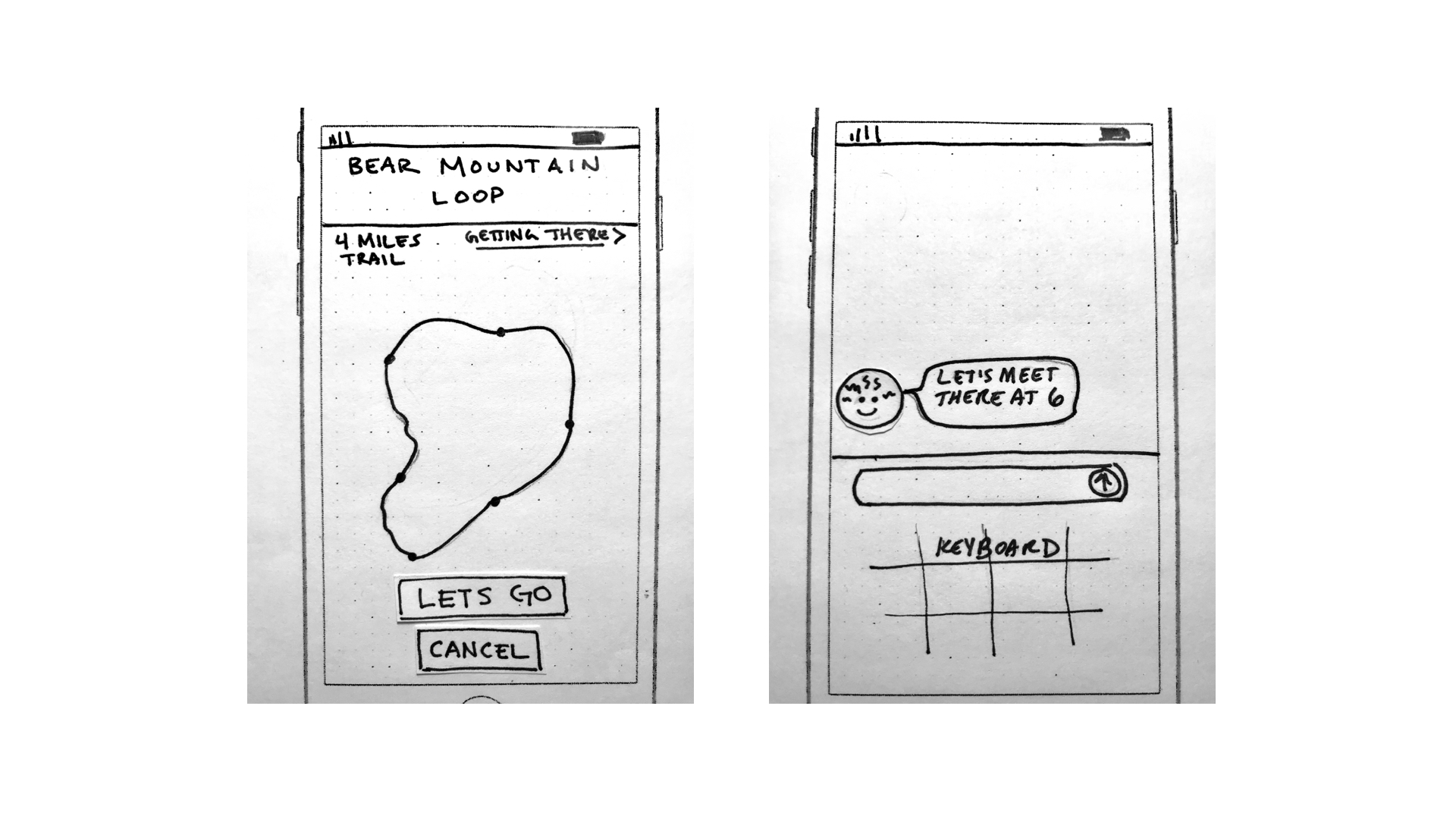
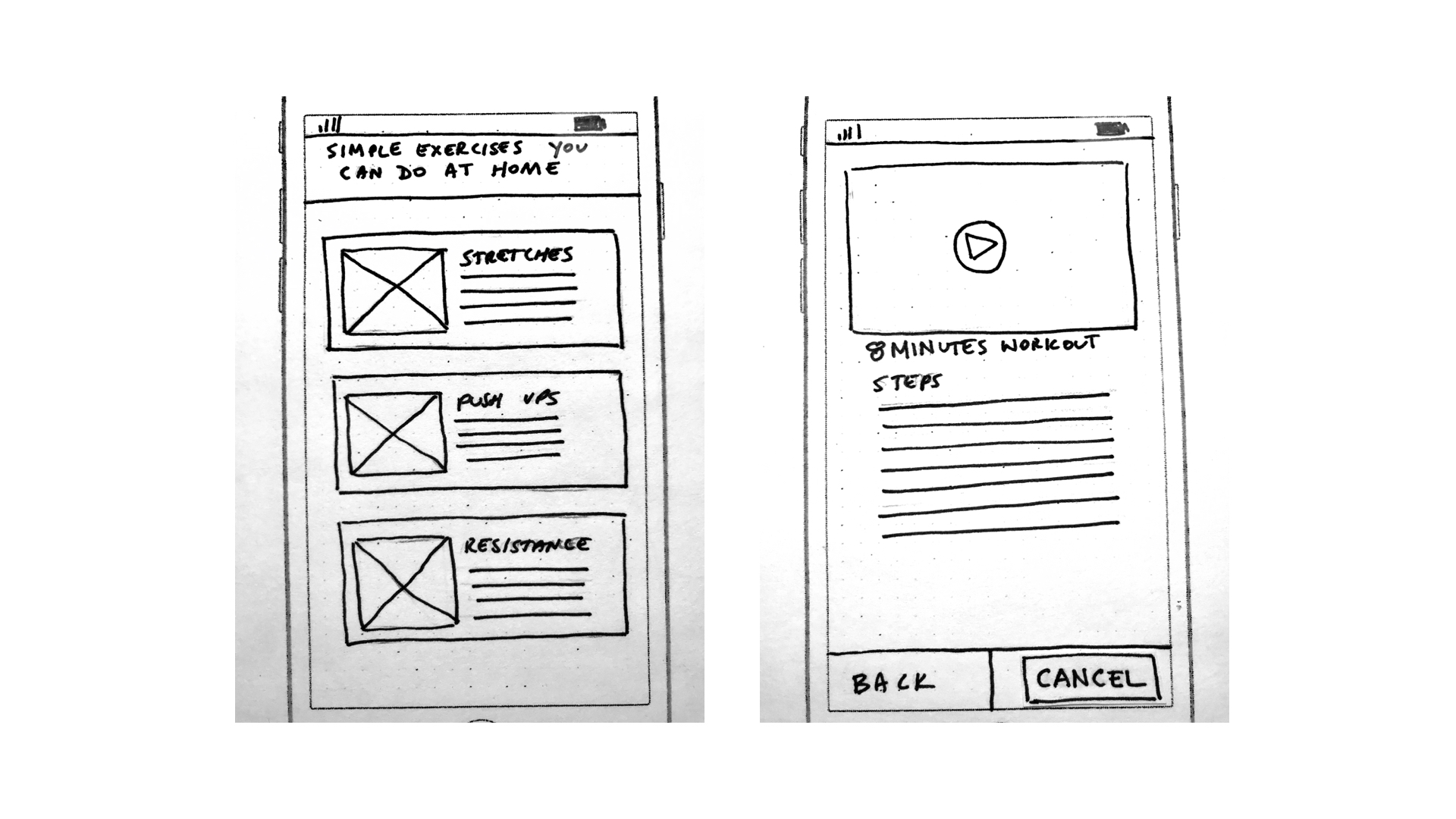
Solution (Prototype)
Usability Testing Brief
- 3 Users Tested based on User Persona
- Between the ages of 25 - 35 years old
Usability Testing
Lily’s Scenario
You want to find a way to be physically active and talk with a professional to help sort your struggles but feel like you don’t have the time to do both.
Lily’s Tasks
- Find someone to go with to a hiking spot.
- You want find some exercises to do at home during the small amount of downtime you have.
Conclusions
- Users found the ‘Home’ icon unclear and confusing what they could do with it
- Users wanted more ways to customize their experience especially in the exercise routines
- Users wanted ways to talk with others
- Users enjoyed that the main icons ‘Tree’ and ‘Dumbbell’ filtered the experience of the app, created a direct flow
- Users want therapists to be involved but might not feel comfortable to go hiking or gym with them
- Users suggested walking with therapist and chatting over phone
“Meeting them in person is a cool feature, but as a girl, I don’t want to meet strangers by myself. Especially on a hike!”
— Usability Tester
Next Steps
Summary of action items to be prioritized:
Working with a therapist
- Include filters for types of therapists (specialists)
- Listing therapists by speciality groups
- Once therapist you want to work with a call to action of 1. Chat, 2. Call, 3. Walk
- ‘Walk’ meaning go for a walk locally with the therapist to get some physical activity and a session in, therapist in this role could help Lily discover areas of NYC
- ‘Walk’ can be now or scheduled depending on availability and need of Lily
Shared Activities
- Turning the ‘home exercise’ section into ‘shared activities’
- ‘Shared Activities’ include activities done by other users of the app to help them relieve stress and other conditions — they share the steps/routine and how it helped them.
- Other users who have tried the routine express how it has helped them too in comments
Physical at Home
- Filters that include different activities that you can string together as your try them or build something you know and want
- Set a timer to each activity, give a timeframe — this is important for Lily with a busy schedule in a new city
- Turning the ‘gym therapist’ into a way to build your own at home destress routine
These were developed to address users concerns and interests in
- Understanding the main buttons
- Customizing exercise routines
- Other ways to choose your own therapist and interact in a way that doesn’t require going on a hike
- To learn from others what works to help manage their stress.
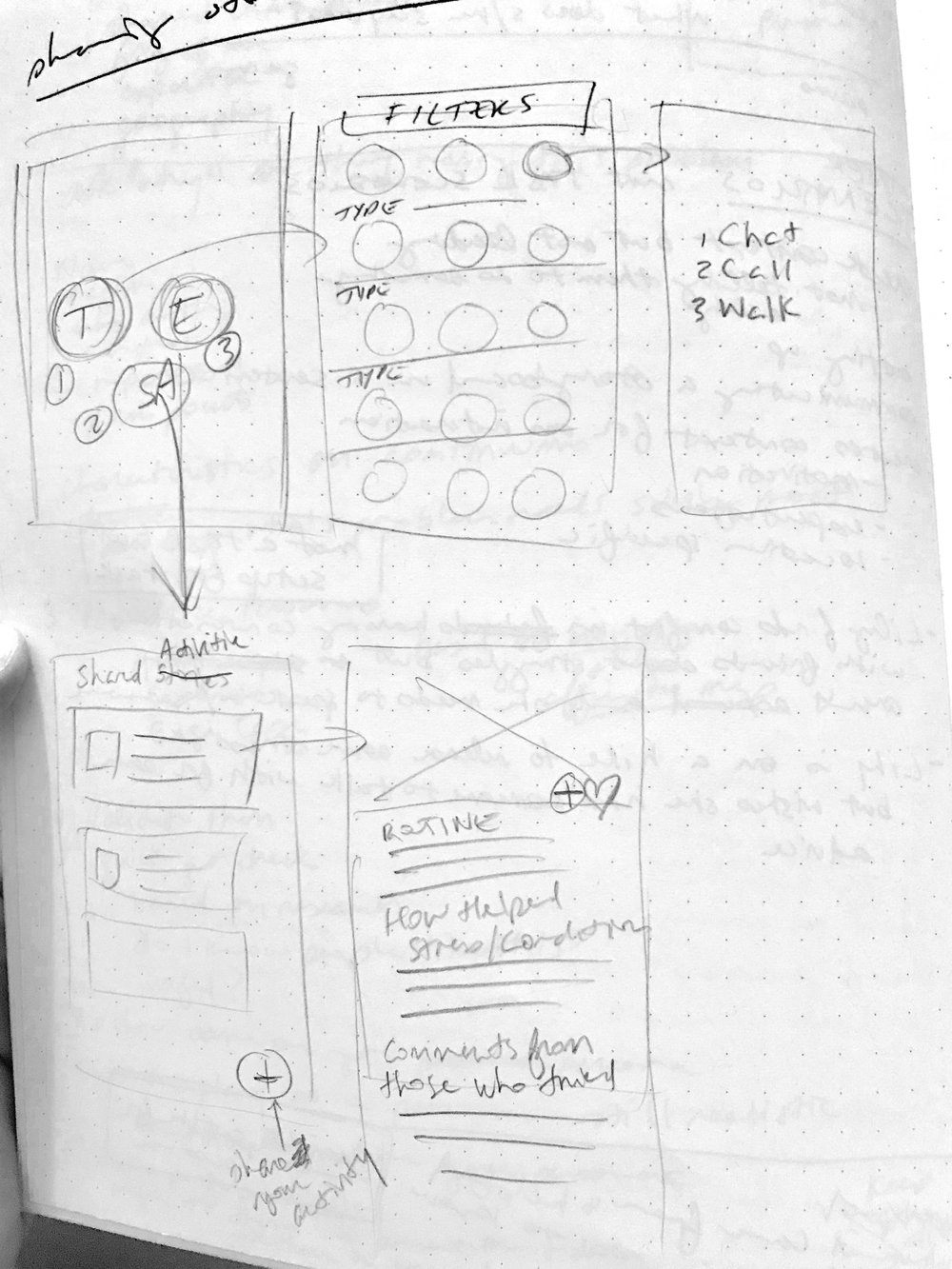
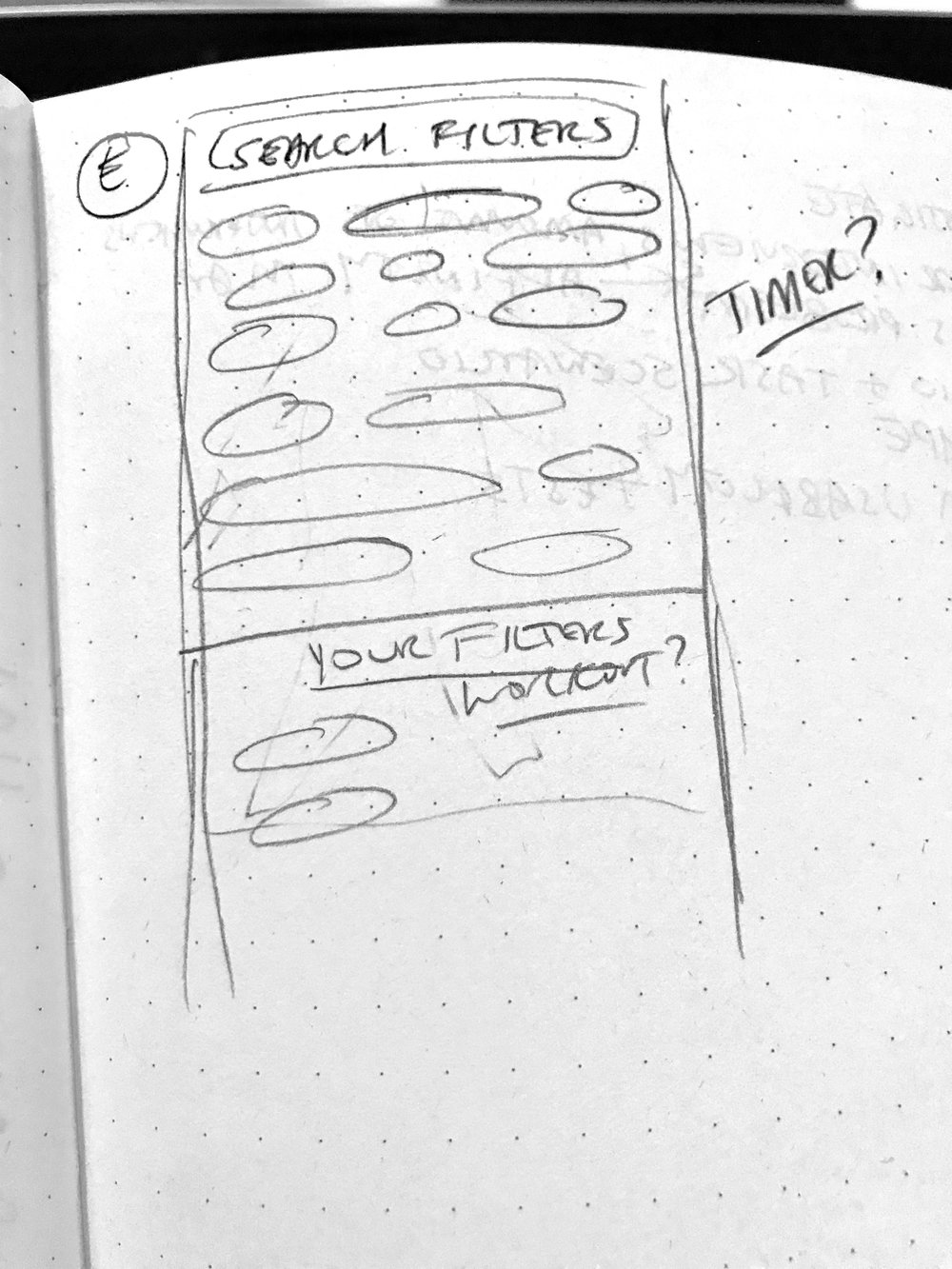
What I Learned
- Managing my own assumptions versus user behaviors.
- It is exciting to pivot and how that can give a project focus.
- The need for research of the practice and industry of therapy.
“Being honest, educating yourself can translate into having better communication with my doctor or counselor. Being comfortable with those questions about overall health or illnesses and having those honest discussions with those can further your health. It’s like being your own advocate, your own health advocate, yes you have friends that support you but to be your own advocate, investigator, researcher, you just don’t want to go in a doctor’s office and let them say or do what they say.”
— User Interview